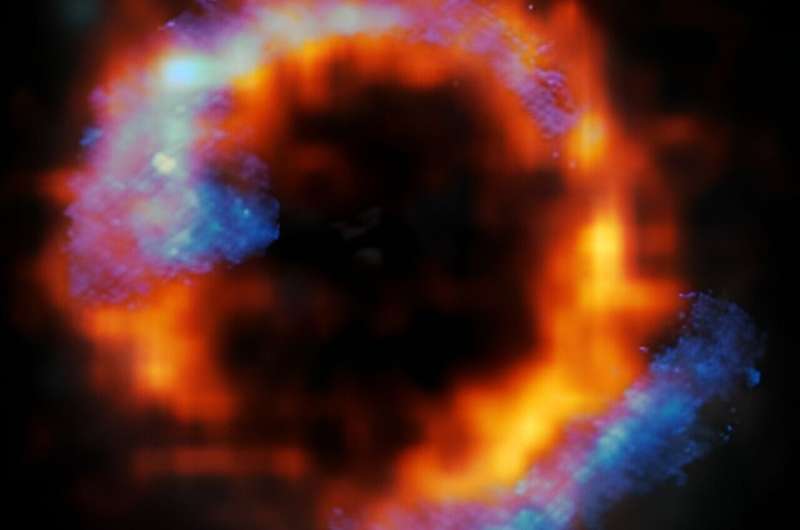This article has been reviewed according to Science X's editorial process and policies. Editors have highlighted the following attributes while ensuring the content's credibility:
fact-checked
peer-reviewed publication
trusted source
proofread
Surprising ring sheds light on galaxy formation

The question of what triggers the extremely rapid star formation within Hyper Luminous Infrared Galaxies (HyLIRGs), as yet unknown, is of much interest to guide our understanding of the formation and evolution of galaxies in the universe. A new photo released by the European Southern Observatory shows a HyLIRG 10,000 times brighter than our Milky Way (in infrared light)—the distant galaxy PJ0116-24—and was released in conjunction with a newly published paper in Nature Astronomy that sheds light on its formation.
Previous studies suggested that such extremely bright galaxies must result from galaxy mergers. These galaxy collisions are thought to create dense gas regions in which rapid star formation is triggered. But isolated galaxies could also become HyLIRGs via internal processes alone, if star-forming gas is rapidly funneled towards the galaxy's center.
In the paper titled "Detailed study of a rare hyperluminous rotating disk in an Einstein ring 10 billion years ago," on which Cornell astronomer Amit Vishwas, Ph.D. is a co-author, observations from ESO's Very Large Telescope (VLT) and the Atacama Large Millimetre/submillimetre Array (ALMA) were combined to study the motion of gas within PJ0116-24.
ALMA traces cold gas, seen in the photo in blue, whereas the VLT, with its new Enhanced Resolution Imager and Spectrograph (ERIS), traces warm gas, shown in red. Thanks to these detailed observations, the international research team discovered that the gas in this extreme galaxy was rotating in an organized fashion, rather than in the chaotic way expected after a galactic collision––a surprising result. This shows, said the researchers, that mergers aren't always needed for a galaxy to become a HyLIRG.
PJ0116-24 is so far away that its light took about 10 billion years to reach us. A foreground galaxy acted as a gravitational lens, bending and magnifying the light of PJ0116-24 behind it into the Einstein ring seen here. This precise cosmic alignment allows astronomers to zoom in on very distant objects and see them in a level of detail that would otherwise be very hard to achieve.
Vishwas, a research associate at the Cornell Center for Astrophysics and Planetary Sciences (CCAPS), helped map the emission and kinematics from atomic and molecular gas in PJ0116-24 using ALMA, which provided strong support for the rotating disk scenario. He was also involved with obtaining data with the newly commissioned ERIS instrument on the VLT. The research was led by Daizhong Liu from Max Planck Institute for Extraterrestrial Physics and Purple Mountain Observatory.
The interpretation of the gas conditions and elemental abundances in PJ0116-24 are similar to what Vishwas and his co-authors reported last year for another galaxy at an earlier epoch in the universe, using data from the James Webb Space Telescope.
PJ0116-24, however, is around five times more massive and luminous than the source studied in last year's paper, said Vishwas.
"In both cases, gravitational lensing helped us zoom in to study the details of the interstellar medium of these galaxies. I believe these new observations are helping us build an argument for the way galaxies evolve and build up—efficiently converting gas to stars in rapid growth spurts separated by long periods of relative calm," he explained.
More information: Daizhong Liu et al, Detailed study of a rare hyperluminous rotating disk in an Einstein ring 10 billion years ago, Nature Astronomy (2024). DOI: 10.1038/s41550-024-02296-7
Journal information: Nature Astronomy
Provided by Cornell University




















